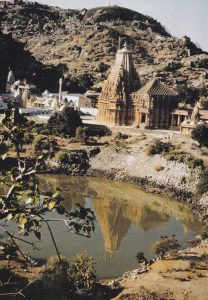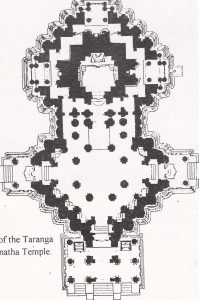Taranga Hill
 The photograph on the opposite page should suffice to show that there is more to see at Taranga than just another temple. Still, if it was only this one sacred edifice and the nearby Digambara shrine with the lofty manastambha in front of it, a much more tiresome journey than the one from Idar would be justified.
The photograph on the opposite page should suffice to show that there is more to see at Taranga than just another temple. Still, if it was only this one sacred edifice and the nearby Digambara shrine with the lofty manastambha in front of it, a much more tiresome journey than the one from Idar would be justified.
Situated so close to Idar, Taranga Hill can be reached by car within a few hours; by public bus it takes some- what longer. Once there, every moment spent at this jewel of a place means being in touch with what matters so much in one’s life as a human being.
Buddhists seem to have been the first religious occupiers of Taranga Hill. An image was unearthed that was identified as a representation of the Mahayana Buddhist goddess Tara. From the worship of this idol the name of Taranga is likely to have been derived.
unearthed that was identified as a representation of the Mahayana Buddhist goddess Tara. From the worship of this idol the name of Taranga is likely to have been derived.
Later it was Digambara Jainas who settled on this isolated hill with it’s three rocky peaks.
Then at some time in the twelfth century, Kumarapala, the Solanki king residing at Patan, who was himself a Shvetambara Jaina, selected this site for the erection of an exceptionally beautiful temple in honour of Ajitanatha. Some years carlier he had a temple built to Adinatha on Mount Shatrunjaya near Palitana.
Built of light sandstone, the Taranga temple measures 45 metres in length by 30.4 metres in width and reaches up to a majestic height of 30.6 metres.
 In its plan and design it resembles the Neminatha temple on Mount Girnar and the above mentioned Adinatha temple on Shatrunjaya. The temple on Mount Girnar is lower in height and less ornate, and the Shatrunjaya Adinatha temple has lost some of its original features in the process of restoring damage caused by Muslim raiders.
In its plan and design it resembles the Neminatha temple on Mount Girnar and the above mentioned Adinatha temple on Shatrunjaya. The temple on Mount Girnar is lower in height and less ornate, and the Shatrunjaya Adinatha temple has lost some of its original features in the process of restoring damage caused by Muslim raiders.
Thus, most visitors will agree with Harihar Singh, author of Jaina Temples in Western India, who named the Ajitanatha temple of Taranga (dedicated 1164) the “grandest and loftiest temple in Gujarat.” The white marble statue of Ajitanatha in the main sanctum measures 2.75 metres in height.
During the last major renovation works the roofs and the stone carvings on the outer walls were cleared of thick layers of white paint, a praiseworthy undertaking.
Recently a new block of comfortable guest-rooms has been added to the existing  ones. Meals are served twice a day.
ones. Meals are served twice a day.
On the highest elevation of the three-peaked hill there stands a so-called tonk. a small building in the style of a Muslim grave. Built by Digambaras, it houses a marble statue of Mallinatha (ill. 241), the nineteenth Tirthankara who the Shvetam- baras believe to have been a woman. To accompany the pujari on his daily morning round up to this picturesque spot is a vigorous hike that opens beautiful bird’s-eye views of the temples below.
Taranga Hill. Ajinatha Temple, dedicated 1164. Sandstone. Left of the big shrine the Digambara temple complex. The tonk with the Mallinatha statue shown in illustration 241 is visible in the background on the centre hill. More such tonks containing Jina images dot the top of the rocky peak from which this photo was taken.
Taranga Hill. Interior of a temple outbuilding containing a sculptural model of Nandishvara-dvipa, that mythical island of fifty-two sanctuaries, thirteen in each of the four directions, where the gods gather whenever the birth of a Tirthankara is to be-cele- brated. No humans live on that island.
 Stele with Jina Mallinatha around which a domed chapel (rank) has been built on the highest of Taranga’s three peaks.
Stele with Jina Mallinatha around which a domed chapel (rank) has been built on the highest of Taranga’s three peaks.
Plan of the Taranga Ajitnatha Temple
Taranga Ajitanatha Temple; view of the tower from the west. The balcony-like structures are not accessible from within, they are ornamental devices.